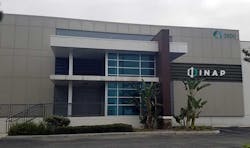Colocation provider INAP filed for Chapter 11 bankruptcy today, citing the need to strengthen its capital structure after failing to find a buyer or strategic partner. The company said it would continue operating and supporting its customers, and that the bankruptcy restructuring would allow it to significantly reduce its debt load.
The bankruptcy filing arrives amid an unsettled financial landscape, with steep declines in global markets amid the spread of the Coronavirus.
In its prepackaged Chapter 11 petition, INAP reported assets of $724 million and debts of $785 million. In a prepackaged filing, the lender and its creditors negotiate a restructuring plan prior to the filing, an approach that can shorten the trip through the bankruptcy process. INAP stock fell 58 percent on the day to 14 cents a share.
INAP operates in 21 markets around the world, offering high-density colocation, managed cloud hosting and powerful network services. INAP has more than 1 million square feet of data centers, including about 600,000 square feet of technical data center space.
“After a thoughtful evaluation of all available options, today, we are taking decisive action to strengthen our capital structure,” said Peter Aquino, Chairman and Chief Executive Officer. “We expect to emerge quickly, financially stronger and well positioned to deliver our comprehensive portfolio of premium data center infrastructure, best-in-class cloud solutions and high-performance network services well into the future.”
INAP and each of its U.S. subsidiaries made Chapter 11 filings in the U.S. Bankruptcy Court for the Southern District of New York. In addition to Internap Corproation, the entities filing include DataGram LLC, Hosting Intellect LLC, Internap Connectivity LLC, Singlehop LLC and Ubersmith Inc.
Chapter 11 provides relief from creditors while a company reorganizes its finances, with the bankruptcy court overseeing and approving its operations as it restructures. INAP had been exploring strategic alternatives for some time, but said it had agreed to a restructuring with a lending group holding 77 percent of its debt. The lenders will provide INAP with $75 million in debtor-in-possession (DIP) financing, which will provide cash for the company to operate while it is in Chapter 11.
“We appreciate the support we have received from our existing lender group, which underscores their belief in our business and commitment to its growth,” added Michael Sicoli, President and Chief Financial Officer. “We look forward to working with them closely as we move ahead to invest in our business to meet the ever-growing demands of our customers and channel partners.”
INAP said it has filed motions with the court to allow it to pay its employees and their benefits, as well as make vendor payments for goods and services, all of which are typical in the Chapter 11 process and subject to court approval. INAP said it expects these motions to be heard in the first few days of its case. INAP has also requested authority to pay all pre-petition trade payables in the ordinary course throughout the Chapter 11 process.
INAP’s non-U.S. subsidiaries, including iWeb Technologies, Internap Network Services U.K. Limited, Internap Network Services B.V., SingleHop B.V. and INAP Japan, are not part of the company’s Chapter 11 cases, but are “expected to benefit from the company’s improved financial structure.”
In its Chapter 11 petition, Internap Inc. listed its largest debtor as construction firm Burr Computer Environments, which is owed $3.1 million. Other debtors include Zayo Group ($849,546), Equinix ($769,572) and Akamai Technologies ($428,514).






